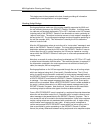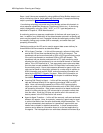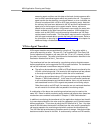
2-13
ASAI Application Planning and Design
With a consult transfer, the merge takes place
after
the second call is delivered to
the second, specialized agent. In this case, the original call is still on hold at the
first agent’s phone when the second call is delivered to the second agent. Hence,
for consult transfers, the VIS can only provide information related to the second
call in the CONNECT event for the second call. In particular, the call ID of the
original call is
not
reported in the Other Call ID field of the CONNECT event for the
second call. The host application must use a mechanism other than call ID’s to
associate the original call with the second call. The alternate mechanism is the
Calling Party Number information as discussed later.
Blind Transfer
With a
blind transfer
, the screening agent does not talk to the specialized agent
before completing the transfer. With this type of transfer, the VIS retains the call
ID of the original call and reports it in the Other Call ID field of call events for the
transferred call. Also, other ASAI information such as ANI and DNIS related to the
original call is reported in the call events for the transferred call. A typical call flow
for blind transfers is described below. In this call flow, Agent 1 is a live agent in a
screening split who transfers calls to specialized agents. Agent 2 is a specialized
agent that can receive calls via a monitored VDN or ACD split or can be a regular
extension. Calls to Agent 1 in the screening split must be delivered via a moni-
tored VDN or ACD split.
1. A call arrives for Agent 1.
2. Agent 1 answers the call and enters pertinent information about the calling
customer.
3. Agent 1 transfers the call to Agent 2. This is done by pressing the transfer
button, dialing the VDN, split, or individual extension and pressing the
transfer button again.
4. Agent 1 is finished with the call.
5. The host application uses call ID information reported in CONNECT events
to determine which data to display on Agent 2’s data-terminal screen. The
call ID from the Call ID field of the CONNECT event for the original call
matches the call ID provided in the Other Call ID field of the CONNECT
event for the transferred call.
Two CONNECT events are passed to monitoring scripts for the entire scenario,
that is, one for the original call to the screening agent and one for the transfer to
the specialized agent. One END event is generated when the call eventually ter-
minates. Refer to Appendix B, “Call Flow Examples” for detailed call flow exam-
ples which include complete descriptions of call flows and call event contents.
The persons responsible for administration and application development must
thoroughly understand the call flow described previously. In addition, note the fol-
lowing:


















